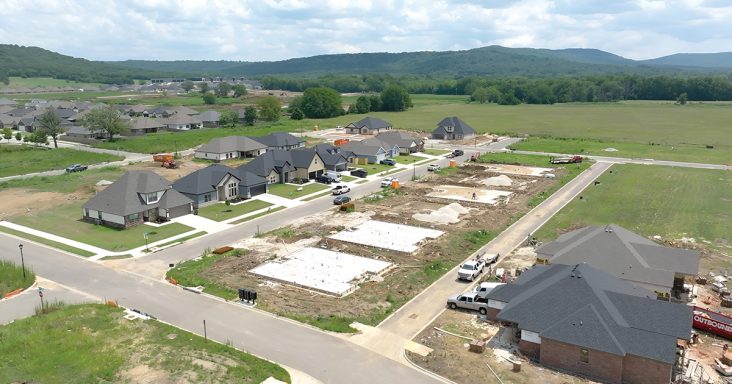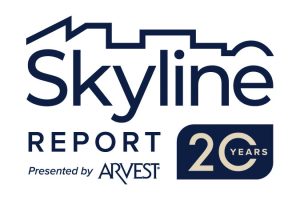20 years of Arvest’s Skyline Report helps bankers, developers
by September 11, 2024 5:09 pm 990 views

It was the early 2000s, and it seemed like every other person in Northwest Arkansas with a hammer and a tape measure was a home builder.
“Teachers, lawyers, doctors, everybody was a spec builder. And you know what, for a long time everybody was a successful spec builder, too. If you built it, you sold it, you made money and you moved on. Until you couldn’t. I will tell you that the day you couldn’t, you couldn’t,” said Kent Williamson, president of Arvest’s Springdale market, who in 2004 was an Arvest loan manager in Springdale.
It was the “couldn’t” that concerned Arvest bankers. They needed insight, data, and real-time analysis of the data to better understand how many couldn’ts might be around the corner.
“We could keep up with what was going on at Arvest, but we weren’t the only players in town,” Williamson said of their thinking in the early 2000s. “So it wasn’t just about what you were doing; it was about what you were doing along with all of your competition and trying to keep up with all of what was happening.”
Arvest turned to the research folks at the Center for Business and Economic Research (CBER) at the University of Arkansas’ Sam M. Walton College of Business. At the time, Jeff Collins and Kathy Deck were the CBER director and assistant director, respectively, and led the effort to craft the first Skyline Report published in 2004.
While complex in terms of data collection and analysis, the Skyline Report continues to provide Arvest bankers with a detailed report on real estate in Northwest Arkansas. Arvest uses the data to work with customers who are developers or have other real estate development roles. The bank also releases an abridged version of the report to aid public and private sector decision makers.

‘MOVIE’ NUMBERS
Williamson said the impact of Skyline data has changed from the initial snapshots of data to now providing 20 years of revelatory trend lines.

“When we first did it, it was more of a picture, you know, it was a snapshot of where you are today. We didn’t have any reference points. I think what’s been great about the Skyline over the years is those pictures have kind of come into being a movie, so you can see it, the trends over a long period of time,” he said.
It’s a movie with some incredible numbers.
Jeff Cooperstein, a CBER senior research assistant who works with CBER Program Coordinator Mary Davenport on data collection, said leasable commercial space tracked by Skyline has grown 472% from 9.9 million square feet in 2004 to 52.7 million square feet in 2024. There were 15,700 apartment units in the 2004 report and 55,300 units in the most recent report — a gain of 252%, or an average of 1,980 new units per year.
And what about those residential subdivision lots fueling some of the anxiety that resulted in the Skyline Report? The most recent Skyline report had around 22,000 lots, up 162% compared with the around 8,400 lots in 2004. The number of active subdivisions has risen 189% from 129 in 2004 to 373 in 2024 — or a little more than 12 new subdivisions developed every year in Benton and Washington counties.

Since 2004, there have been 152 Skyline Reports with 12,006 pages of data. Two to three student workers help Cooperstein and Davenport with each report.
“I think the residential subdivision absorption rates, gained by putting eyes on around 25,000 subdivision lots, is unmatched by most real estate reports. We also provide detailed vacancy rates for the Northwest Arkansas multifamily and commercial real estate markets, which can be a lot more volatile without good data,” Jebaraj noted.
Developers and investors from outside of Northwest Arkansas also have benefited from the report, according to Cooperstein.
“Additionally, the Skyline Report is read by and CBER is contacted by developers in other states such as California, Texas, New York, Florida, Missouri, Tennessee, Oklahoma, Kansas, to name a few. This connection has helped facilitate financial resources from those states in helping build NWA,” he wrote in an email interview with the Northwest Arkansas Business Journal.
‘ENOUGH WAS ENOUGH’
Not all the numbers are certain.
The global financial crisis of 2008 — fueled in part by lax regulations and poor oversight of subprime residential mortgages — had reached the red-hot Northwest Arkansas housing market. Cooperstein said Skyline data began to show in 2006 some overbuilding in the Northwest Arkansas housing market.
Williamson said it is hard to know how much the report may have helped regional bankers, developers and spec builders avoid financial mistakes. But he’s inclined to believe it helped the bank make better decisions.
“But what you don’t know is what your losses would have been if you didn’t have the Skyline,” he said.
After a pause, he continued: “I would probably tell you, ‘Yes.’ … We probably stepped away from some things that we might have done five years before, but we were not going to do it now because of the [Skyline] numbers.”
He said there were some large deals still being made then that Arvest made tough decisions to not finance, but “ultimately, we were very glad that we were not involved in them.”
“We started to know that enough was enough. When the market stopped, the market stopped,” he said.
Williamson stressed that developers who at that time also had access to Skyline data were deciding to pull back.
“It wasn’t just what the banks didn’t do. How many requests did you not get from customers who were saying, ‘I think I’ve seen enough. I think I need to pull out.’ So there were probably a lot of requests that didn’t come our way because they [developers] were informed, and they didn’t move forward,” he said.
Williamson said the housing picture is now much different, with demand outpacing supply. But lessons learned from that period remain, and the report helps the bank watch for potential emerging problems.
“That’s probably what has been more helpful is that we’ve had trends now for 20 years. We know what happened in 2008, and we don’t want to get back into that point. … And so I think the issue has changed over the years of what is really the hot spot and what you need to be looking for.”
COMMUNITY BANKING
Jebaraj reiterated Cooperstein’s note that Skyline Report data has helped outside developers and investors bring their resources to the region. He also said the report will continue to adapt to meet changing development realities.
“The inclusion of the Skyline Report into the development culture in NWA is pretty gosh darn cool. The Skyline report connects developers in other states with Northwest Arkansas contributing to increasing development,” Jebaraj noted in a statement. “As the region grows, we have been adding new types of commercial space to our report and expanding its coverage in smaller cities in the area. With cities and counties slowly adopting more GIS [geographic information system] information, we will be able to add more maps of our data in the future.”
A similar report would also be helpful in slower-growth metro areas, according to Cooperstein, noting that it “would provide better information to help with better decision making, and that might be the marginal difference needed to change a metro from slow or lower growth to faster growth.”
“Also, I think a Skyline-type report, if done like ours, helps bring stakeholders in the development community together, and that is a positive regardless of the pace of growth,” he said.
But with all the dramatic development changes statistically revealed in 20 years of Skyline Reports, the role of a banker is largely the same, according to Williamson.
“Northwest Arkansas is still about community banking, and knowing our customers and having a care for our communities that we live in and a care for those customers. I think that part has stayed the same. I think that the thing that’s different is just that loans are bigger. What used to be a $100,000 home loan is now a $500,000 home loan.”
